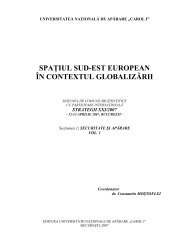Impact strategic nr.6-7 - Centrul de Studii Strategice de Apărare şi ...
Impact strategic nr.6-7 - Centrul de Studii Strategice de Apărare şi ...
Impact strategic nr.6-7 - Centrul de Studii Strategice de Apărare şi ...
- No tags were found...
Create successful ePaper yourself
Turn your PDF publications into a flip-book with our unique Google optimized e-Paper software.
ACTUALITATEA POLITICO-MILITARĂ<br />
At present, there are used three types of <strong>strategic</strong>al<br />
planning:<br />
a) Based on threats in security environment. (immobile<br />
background);<br />
Traditionally, <strong>strategic</strong>al planning was based upon<br />
fighting against the threats insi<strong>de</strong> the security environment.<br />
The threats are represented by the actions done by<br />
state actors that affect the national interests of a country.<br />
During this planning process, there are evaluated the<br />
intentions of the potential aggressor and its possibilities<br />
in time and space.<br />
b) Based on own military capabilities (flexible background);<br />
The difference this type of <strong>strategic</strong>al planning and<br />
the previous one consists on the fact that dimensioning<br />
the force structure of a state is not in concordance with<br />
the real or potential threat but exceeds it. In this case, the<br />
force structure is seized on other criteria, the political<br />
power aims imposing the supremacy of that country in its<br />
areas of <strong>strategic</strong>al interest. The best examples are North<br />
Korea and Iraq. They use most part of their economical<br />
resources in or<strong>de</strong>r to <strong>de</strong>velop over-dimensioned forces<br />
structure. Therefore, they try to become regional power<br />
lea<strong>de</strong>rs although their military power is not sustained by<br />
an economical potential.<br />
This planning system is not flexible and does not allow<br />
a fast adjustment to the changes done in the security<br />
environment.<br />
c) Based on counteracting the risks and vulnerabilities<br />
(exten<strong>de</strong>d, flexible background)<br />
The USA and NATO’s armies use this type. This pattern<br />
of <strong>strategic</strong>al planning does not try to i<strong>de</strong>ntify enemies,<br />
but phenomenon generating the <strong>de</strong>stabilization of the<br />
international or<strong>de</strong>r or tat might put in danger the security<br />
and stability of some states area or regions. The risks may<br />
be intensified by the internal vulnerabilities of the state or<br />
other actors who have responsibilities or managing security<br />
or international organizations (UN and OSCE).<br />
The next step of <strong>strategic</strong>al planning, although issued<br />
only by the US military planners, is based on knowledge<br />
and information in a fluid and digitized battlefield.<br />
Promoting security by cooperation is shadowed by negative<br />
phenomenon like proliferation of weapons of mass<br />
<strong>de</strong>struction, international terrorism, and intolerance.<br />
The risks and vulnerabilities in the security environment<br />
are i<strong>de</strong>ntified in strategies by military analysts and<br />
planners. They are mentioned in the official papers, in long<br />
term <strong>strategic</strong> visions, national security strategy, military<br />
strategies and doctrines. Our country has elaborated this<br />
set of political-military documents that are the base of<br />
the <strong>strategic</strong>al planning. The <strong>strategic</strong>al vision 2010 of<br />
Romania’s Armed Forces, The Short Term <strong>strategic</strong>al<br />
evaluation of security environment, <strong>strategic</strong> plans on<br />
Using Force, the Defense Planning Directive, the Doctrine<br />
of Joint Actions (Operations) of the Armed Forces,<br />
the Multinational Operations Doctrine, the Armed Forces<br />
Doctrines, the Departments (Js) of the General Staff,<br />
handbooks and rules of operations in different military<br />
structures. Up to May, 2004 all these documents have to<br />
be revised and adjusted to the NATO’s requirements.<br />
3. New Society, New War and New Military Lea<strong>de</strong>r<br />
The recent history shows the stressed need of new<br />
lea<strong>de</strong>rs, able to lead the society. The present international<br />
events, Iraq crisis represent a source for analyzing the<br />
different ways of leading at the political, military and<br />
economical levels.<br />
Meantime, the confrontation between world powers<br />
on battlefields or stock exchange may be seen as signs<br />
of leading change at worldwi<strong>de</strong> level. “The old mo<strong>de</strong>l”<br />
of organizing the world power has ero<strong>de</strong>d continuously<br />
after 1989 and doesn’t respond to the present or future<br />
challenges. That is why building, planning a new future,<br />
a new lea<strong>de</strong>r is nee<strong>de</strong>d.<br />
Useful on this purpose is Leading US Army Handbook.<br />
The Chief of US Land Forces General Staff, General Eric<br />
Shinseki asserts that the fundamental principle will be “to<br />
be a lea<strong>de</strong>r, to know and to act as a lea<strong>de</strong>r”. Starting from<br />
moral values set- professionalism, loyalty, team spirit,<br />
duty, respect, honor, personal courage adding abilities and<br />
competencies you may star acting like a comman<strong>de</strong>r.<br />
This handbook stresses the importance of the comman<strong>de</strong>rs’<br />
value, those ones who have to put into practice<br />
principles expressed in sophisticated terms. The conclusion<br />
of the chapter on the lea<strong>de</strong>r’s position versus the changing<br />
nature of the dangers the US Army has to confront with<br />
is that “change is inevitable; it is useless to try to <strong>de</strong>ny it<br />
(…). In real terms, leading means adjustment, handle the<br />
change and subordinate into your purpose”.<br />
The new post-industrial society needs an ongoing<br />
adjustment process to the requests, risks, changes and<br />
threats of the moment. Projecting and building a political<br />
and military architecture are more and more <strong>de</strong>pen<strong>de</strong>nt on<br />
realistic, positive, perspective visions. Military planning<br />
has and will have an essential role in getting performance;<br />
and performance has already become the condition of the<br />
social existence in the third millenium world.<br />
IMPACT STRATEGIC nr. 1-2/2003<br />
33


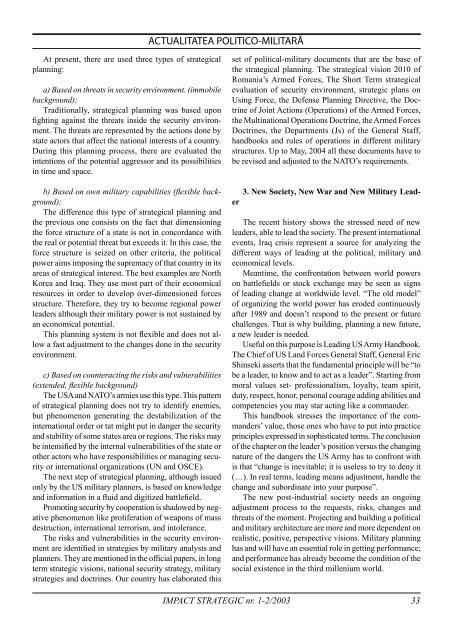


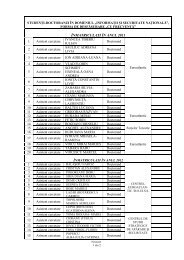
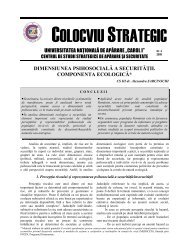
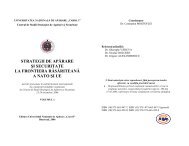
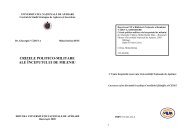


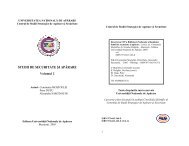

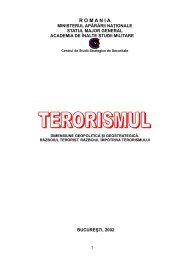
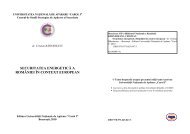
![„CAROL Nr 4 [29]/2008](https://img.yumpu.com/53801719/1/184x260/carol-nr-4-29-2008.jpg?quality=85)
